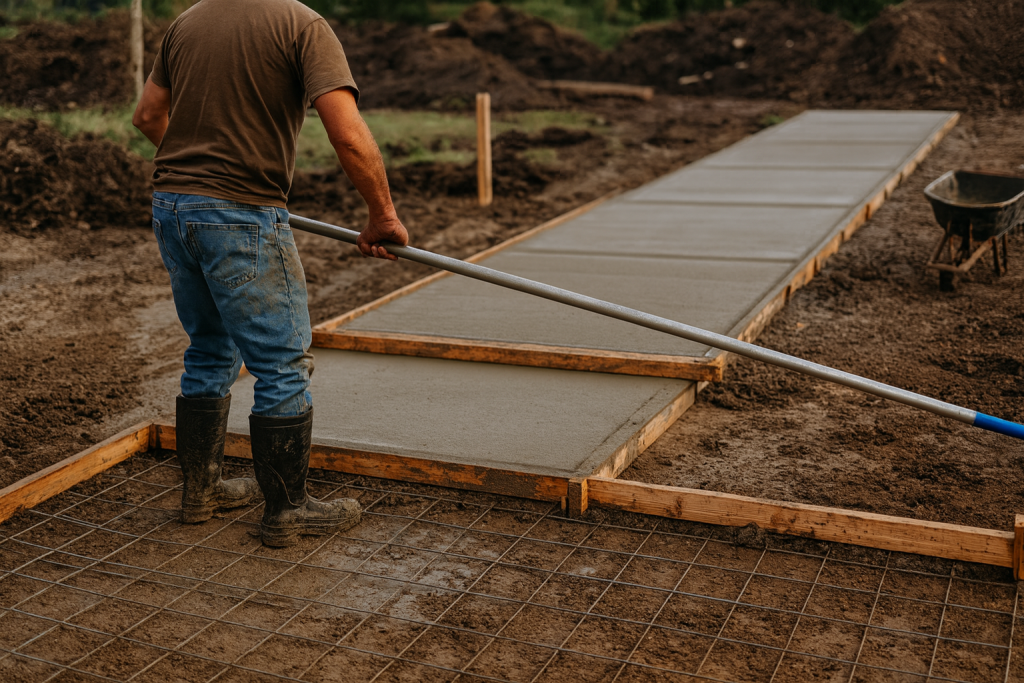
Every great building starts from the ground up and the ground beneath it needs to be strong, reliable, and built to last. Whether it’s a small backyard patio, a residential home, or a massive commercial development, one material determines the strength, safety, and longevity of the entire structure.
While concrete is everywhere in construction, not all concrete is created equal. The difference between average concrete and high-quality concrete can be the difference between a structure that stands for decades and one that begins to crumble in a few years. This is especially true in regions like Manitoba, where extreme temperature changes, freeze-thaw cycles, and moisture take a heavy toll on building materials.
Quality concrete isn’t just cement mixed with sand, gravel, and water, it’s a carefully engineered product. It requires precise mixing ratios, the right aggregates, professional handling, and proper curing techniques to achieve maximum strength and durability. When done right, it can resist cracks, withstand heavy loads, and handle environmental stresses without losing integrity.
For homeowners, contractors, and developers, investing in quality concrete is about more than just getting the job done; it’s about creating something that will stand the test of time, save money in the long run, and ensure safety for everyone who uses the space.
Durability is the first and most obvious benefit of quality concrete. When the mix is right and the curing process is followed, concrete can last for 30 to 50 years or more with minimal maintenance. It resists weathering, erosion, and heavy use. Poor-quality concrete, however, deteriorates much faster. Cracks form more easily, surfaces become uneven, and repairs become a constant expense.
In construction, durability doesn’t just protect the structure, it protects your investment. Whether it’s a driveway that needs to survive heavy vehicle traffic or a commercial floor that bears the weight of machinery, quality concrete ensures long-term strength.
A building’s safety is only as strong as the materials that hold it together. Low-quality concrete can compromise the structural integrity of walls, floors, and foundations, creating safety hazards over time. On the other hand, concrete that meets industry standards provides the stability needed to handle both vertical and horizontal loads without shifting or collapsing.
For homeowners, this means peace of mind. For contractors, it means fewer callbacks and warranty issues. For developers, it means delivering a product that maintains value and meets building codes for decades to come.
In regions like Manitoba, concrete faces some of the harshest weather challenges in Canada. Winters drop to extreme sub-zero temperatures, summers deliver intense heat, and seasonal freeze thaw cycles cause constant expansion and contraction. Low-grade concrete often fails to cope, developing cracks that let in water and lead to even greater damage over time.
High quality concrete includes air entraining agents and other additives that help it handle expansion and contraction without losing strength. Proper curing techniques also ensure it maintains resilience against moisture, road salts, and chemicals all common in our climate.
While high-quality concrete may require a slightly higher upfront investment, it saves money in the long run. Structures built with quality materials need fewer repairs, experience less downtime for maintenance, and last longer before requiring replacement.
For example:
That’s the kind of difference quality makes and the kind of savings it delivers over time.
Concrete is one of those materials that can make even the most skilled construction crew look bad if it’s low quality. High quality concrete flows and sets evenly, allowing for smoother surfaces, cleaner finishes, and stronger joints. This not only improves the appearance of the finished product but also enhances its performance.
When builders work with quality concrete, they can achieve precise results, maintain timelines, and ensure that the structure performs as intended for years.
Modern advancements in concrete production allow for more environmentally friendly options. High quality concrete mixes can include recycled materials like fly ash or slag, reducing the environmental impact while still delivering exceptional strength and durability. Energy efficient curing methods and locally sourced aggregates also reduce the carbon footprint of a project.
Choosing these sustainable options means you’re not only building something strong but also contributing to a healthier planet.
The supplier you choose plays a major role in the quality of your project. Here’s what to look for:
A trusted supplier ensures that your project starts with the right materials and that’s half the battle won.
Concrete might not be the flashiest material on a construction site, but it’s one of the most important. The strength, safety, and longevity of any structure depend on the quality of the concrete beneath it. From foundations to driveways, from commercial floors to bridges, investing in high quality concrete is a decision that pays off for decades.
It’s the right mix proportions, quality aggregates, proper curing, and additives that improve durability and resistance.
When installed and maintained properly, it can last 30–50 years or more.
Yes.The long term savings in repairs and replacements far outweigh the small upfront cost difference.
Extreme temperatures and freeze-thaw cycles can damage low-quality concrete, but high quality mixes are designed to handle these stresses.
Absolutely. Even small-scale work benefits from using strong, durable materials.
Ask about their certifications, quality control methods, and customer references.